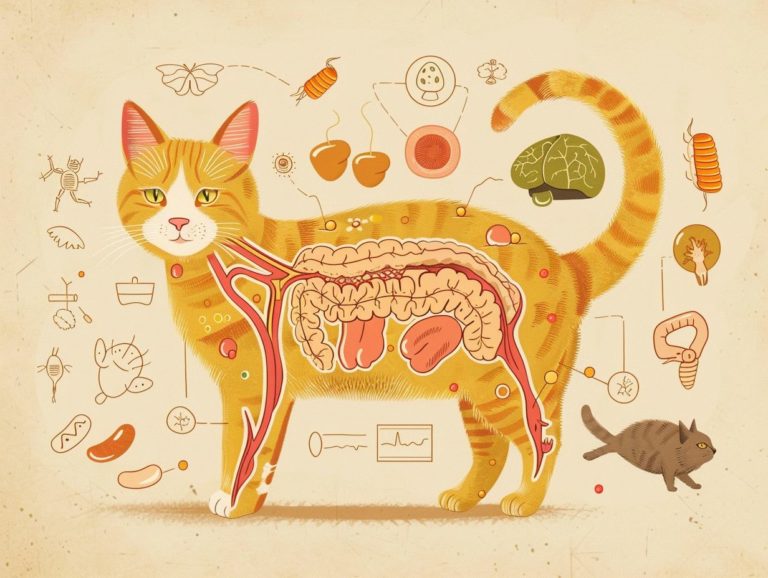Pancreatitis In Cats Causes Symptoms And Treatments
Pancreatitis in cats is a potentially life-threatening condition that all cat owners should be familiar with. This article covers what pancreatitis is, as well as the causes, risk factors, symptoms, diagnosis, treatment, and prevention of pancreatitis in cats. Understanding pancreatitis in cats is essential for the health and well-being of our animal companions.
Key Takeaways:
Understanding Pancreatitis in Cats
Understanding Pancreatitis in Cats involves recognizing the characteristics of pancreatitis in felines, which is an inflammation of the pancreas that can manifest as acute or chronic and requires immediate veterinary attention. Pancreatitis in cats can be triggered by various factors, such as obesity, certain medications, or infections.
The primary symptoms of pancreatitis in cats include vomiting, abdominal pain, loss of appetite, and lethargy. Veterinarians diagnose pancreatitis in cats through blood tests that assess elevated levels of pancreatic enzymes or ultrasounds that enable visualization of the pancreas. Treatment typically entails hospitalization, intravenous fluid therapy, pain management, and specific medications.
Preventing pancreatitis in cats involves maintaining a healthy weight, providing a balanced diet, and monitoring for other conditions like diabetes mellitus that can heighten the risk of pancreatic inflammation.
What is Pancreatitis?
Pancreatitis is the inflammation of the pancreas, an organ in cats that produces digestive enzymes such as amylase and lipase, and regulates blood sugar levels. When the pancreas becomes inflamed in cats, it is known as feline pancreatitis and can have severe health implications if not promptly treated by a veterinarian.
The digestive enzymes produced by the pancreas play a crucial role in breaking down food into nutrients that can be absorbed by the body. If the pancreas fails to produce or release these digestive enzymes effectively, it can lead to improper food digestion in cats, causing digestive issues and potential nutrient deficiencies.
Inflammation in the pancreas can hinder its function in both digestion and the regulation of blood sugar levels, which are essential for a cat’s overall health.
Causes of Pancreatitis in Cats
The causes of pancreatitis in cats involve investigating triggers and risk factors that contribute to the development of pancreatic inflammation, beyond underlying conditions like diabetes mellitus. Factors such as obesity, dietary indiscretion, and infections are known triggers of pancreatitis in cats.
Plus diabetes mellitus, other chronic intestinal diseases such as inflammatory bowel disease can predispose cats to pancreatic inflammation. Exposure to the parasitic protozoan Toxoplasma gondii has also been associated with an increased risk of pancreatitis.
It is crucial for cat owners to understand these potential triggers and risk factors to prevent and properly manage this potentially life-threatening condition in their feline companions.
Possible Triggers and Risk Factors
Disruptions in insulin and glucagon levels can trigger and serve as risk factors for feline pancreatitis because an imbalance in these hormone levels hinders the pancreas’s ability to regulate the body’s blood sugar levels. This imbalance can result in inflammation of the pancreatic tissue, leading to the development of pancreatitis.
Insulin and glucagon play crucial roles in the regulation of the liver and gallbladder functions. Insulin facilitates the storage of glucose in the liver as glycogen, a form of stored glucose, while glucagon prompts the release of stored glucose from the liver into the bloodstream. Any disruption in this intricate interplay can have significant impacts on feline physiological processes, affecting the health of the pancreas and overall metabolic functions.
Symptoms of Pancreatitis in Cats
Recognizing the symptoms of pancreatitis in cats involves observing signs such as loss of appetite, dehydration, and specific blood tests for feline pancreatic lipase immunoreactivity (fPLI) levels. According to the article “Diagnosis and Management of Pancreatitis in Cats” by Mary Ann Crandall, DVM, cats with pancreatitis may also exhibit symptoms like vomiting, lethargy, and abdominal pain.
Veterinarians diagnose feline pancreatitis using specialized blood tests for feline pancreatic lipase immunoreactivity (fPLI), such as SNAP fPL and Spec fPL tests, which detect elevated feline pancreatic lipase levels. X-rays can reveal abnormalities in the pancreas. It is crucial for cat owners to promptly bring their pets to the veterinarian upon observing any of these symptoms, as early recognition and treatment can enhance the prognosis for feline pancreatitis.
Recognizing Signs and Seeking Treatment
Early detection of pancreatitis in cats is crucial for effective management and treatment. The main way it is detected is through clinical signs such as vomiting, lethargy, and weight loss. These signs often lead to hospitalization and intravenous fluid therapy, which is the preferred method for diagnosing acute pancreatitis.
Blood tests to measure pancreatic enzyme levels are a common diagnostic tool, and imaging techniques like ultrasound are frequently used to assess pancreatic structure and function. Anti-nausea medications are commonly administered to control clinical signs while the underlying cause is determined, and nutritional support may be provided in the form of enteral feeding to ensure adequate nutrient intake for recovery.
Diagnosing Pancreatitis in Cats
Diagnosing pancreatitis in cats involves the use of diagnostic methods such as blood tests, imaging, and occasionally biopsy to confirm the presence of pancreatic inflammation.
Blood tests are crucial for diagnosing pancreatitis in cats as elevated levels of specific enzymes such as amylase and lipase indicate pancreatic involvement. Ultrasound examinations play a significant role in visualizing changes in the pancreas and surrounding tissues. Additionally, assessing liver function is essential because pancreatitis can indirectly impact liver enzymes.
Evaluating for dehydration and investigating gallbladder abnormalities are important steps in the assessment for pancreatitis in feline patients.
Common Diagnostic Methods
The primary diagnostic methods for feline pancreatitis typically involve blood tests, ultrasound examinations, and occasionally biopsies to accurately evaluate the degree of pancreatic inflammation and associated complications. Blood tests are essential for identifying elevated levels of feline pancreatic lipase immunoreactivity, the key pancreatic marker for pancreatitis in cats.
Ultrasound examinations offer detailed imaging of the pancreas, enabling veterinarians to visually spot any abnormalities or changes in organ size. If further clarification is necessary, a biopsy may be conducted to acquire tissue samples for a definitive diagnosis. These diagnostic techniques are particularly crucial for distinguishing pancreatitis from other conditions like chronic intestinal diseases, which can exhibit similar clinical signs.
Treating Pancreatitis in Cats
The treatment of pancreatitis in cats typically involves hospitalization, fluid therapy, anti-nausea medications, and nutritional support to address inflammation and manage symptoms of the disease.
In more severe cases, cats with pancreatitis may require hospitalization and intensive care, including intravenous fluids to address dehydration and maintain electrolyte balance. Pain medications may also be administered to alleviate abdominal discomfort.
Dietary adjustments play a crucial role in the recovery process, with a focus on providing easily digestible, high-protein meals to enhance appetite and deliver essential nutrients for healing.
Your veterinarian will collaborate with you to create a tailored treatment plan that meets your cat’s specific requirements and enhances their overall quality of life.
Medications and Therapies
Treatment for feline pancreatitis typically includes pain management, anti-inflammatory drugs, and supportive care aimed at controlling the underlying inflammation and enhancing the overall health of the cat. Supportive care may involve ensuring proper hydration with fluids and maintaining adequate nutrient intake through specialized diets.
In severe cases, hospitalization may be necessary for close monitoring, with intravenous fluids and medications often required. Tailored treatment plans are essential for successful management of feline pancreatitis, as individual cats may respond differently to treatments. Regular evaluations and adjustments to the treatment plan are vital to achieve the best possible outcome for the cat.
Preventing Pancreatitis in Cats
Preventing pancreatitis in cats involves a combination of balanced nutrition, veterinary monitoring, and avoiding sudden dietary changes to safeguard the pancreas from damage and disease, ensuring its proper function and health. Adequate hydration is crucial to support the pancreas in its digestive activities, as untreated feline pancreatitis can advance to a stage necessitating extensive imaging and medical intervention.
Collaborating with veterinarians, pet owners can develop personalized feeding plans and lifestyle strategies. Furthermore, regular monitoring of feline health and behavior can facilitate early detection and treatment of any underlying diseases linked to pancreatitis.
Preventive Measures and Tips for Cat Owners
Preventive measures and tips for cat owners to minimize the risk of pancreatitis include early veterinary intervention, ensuring an appropriate diet, and closely monitoring and promptly responding to noticeable changes such as loss of appetite or behavioral alterations that could signal pancreatic issues.
Maintaining an appropriate diet for cats is essential in preventing pancreatitis, as all commercial cat foods meet their nutritional needs and it is important to avoid high-fat or high-calorie treats. Regular check-ups and blood tests are helpful in detecting early stages of pancreatitis, enabling timely intervention.
Cats with a history of pancreatitis may require specialized veterinary-prescribed customized diets. It is also crucial to carefully monitor the weight and overall health of cats, as obesity is a common risk factor for feline pancreatic disease.
Frequently Asked Questions
What is pancreatitis in cats?
Pancreatitis in cats is a condition where the pancreas, an organ responsible for producing enzymes that aid in digestion, becomes inflamed. This inflammation can be caused by various factors and can lead to serious health complications if left untreated.
What are the common causes of pancreatitis in cats?
The exact cause of pancreatitis in cats is often unknown, but some common factors include obesity, high-fat diet, certain medications, infections, and underlying health conditions such as diabetes or inflammatory bowel disease.
What are the symptoms of pancreatitis in cats?
The symptoms of pancreatitis in cats can vary, but some common signs include loss of appetite, vomiting, diarrhea, dehydration, abdominal pain, and lethargy. In severe cases, cats may also display jaundice or difficulty breathing.
How is pancreatitis in cats diagnosed?
To diagnose pancreatitis in cats, a veterinarian will perform a physical examination and may also recommend blood tests, imaging tests such as ultrasound or x-ray, and sometimes a biopsy of the pancreas.
Can pancreatitis in cats be treated?
Yes, pancreatitis in cats can be treated, but the course of treatment will depend on the severity of the condition. Mild cases may only require dietary changes and medication to manage symptoms, while severe cases may require hospitalization and intravenous fluids to help with hydration and nutrition.
Is it possible to prevent pancreatitis in cats?
While the exact cause of pancreatitis in cats is often unknown, there are some steps you can take to help prevent the condition. These include maintaining a healthy weight for your cat, avoiding high-fat diets, and being cautious with certain medications that can increase the risk of pancreatitis.

